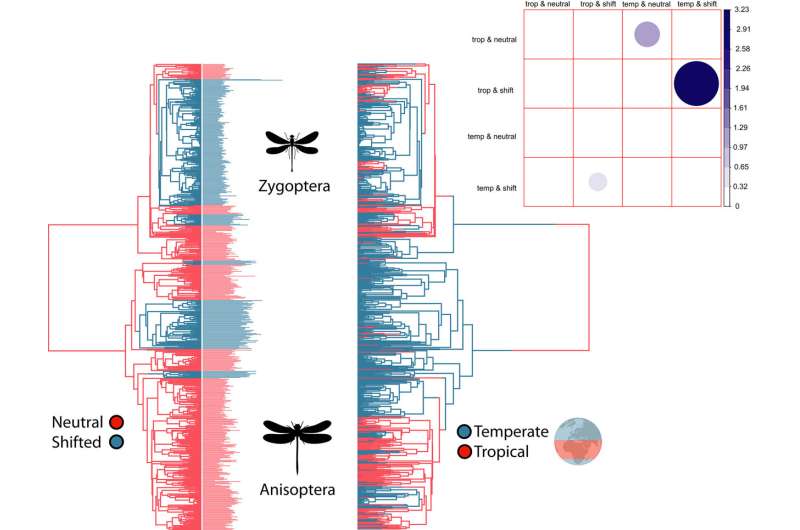This article has been reviewed according to Science X's editorial process and policies. Editors have highlighted the following attributes while ensuring the content's credibility:
fact-checked
peer-reviewed publication
trusted source
proofread
Size of insects is shaped by temperature and predators, shows study

The size of dragonflies and damselflies varies around the globe. These insects are generally larger in temperate areas than in the tropics. According to a new study from Lund University in Sweden, this is caused by a combination of temperatures and the prevalence of predators.
In a large global comparative study of this ancient order of insects, researchers have studied how body size varies geographically and between different species. They compared the size of these insects in the hot tropics with the cooler, temperate regions to quantify geographical variation and understand its causes. This was done by analyzing size data and fossil data for various species of dragonflies and damselflies (two suborders of the order Odonata).
"Two hundred million years ago, these insects were larger in the tropics than in temperate climates. That trend has since reversed, however, and the opposite is now true, with larger species generally found at our northerly latitudes. We believe that this is partly caused by the evolutionary appearance of birds," says Erik Svensson, biologist at Lund University.
The researchers suggest that as birds emerged on the evolutionary scene—around 150 million years ago—they caught more and more dragonflies and damselflies in the tropics.
This pressure from the birds drove the larger insects northward, towards colder areas at higher latitudes, resulting in the global variation in body size that we see today, where the larger species inhabit northern latitudes. In addition to there being more bird species in the tropics, higher temperatures at low latitudes are also partly responsible for smaller body sizes in the tropics.
"We discovered that the regional bird species diversity is a stronger predictor of size than the regional temperatures, when we analyzed how these insects' body sizes varied around the globe. As a whole, species are smaller in warmer climates, but the the link between size and the latitude at which species live has changed since birds began to evolve," says Erik Svensson.
Since birds catch and eat dragonflies and damselflies—and since it is easier for predators to capture larger prey, smaller species do better in the presence of predators. Knowledge of where and why species with different body sizes occur on the planet is important in order to understand the extinction risks of species with different characteristics.
Today, we know that large species often have a higher risk of extinction than smaller species. It is important to be aware of how temperature and the risk of being eaten jointly explain the global body size variation in these insects and other animal groups
"There is currently heavy focus on the climate issue and the significance of temperature in determining the risk extinction risks of species. Our results show how information about predators and body sizes are important to fully understand variation in local, regional and global species composition of this important insect order," concludes Erik Svensson.
The study is published in the Journal of Biogeography.
More information: Erik I. Svensson et al, Out of the tropics: Macroevolutionary size trends in an old insect order are shaped by temperature and predators, Journal of Biogeography (2022). DOI: 10.1111/jbi.14544
Journal information: Journal of Biogeography
Provided by Lund University




















